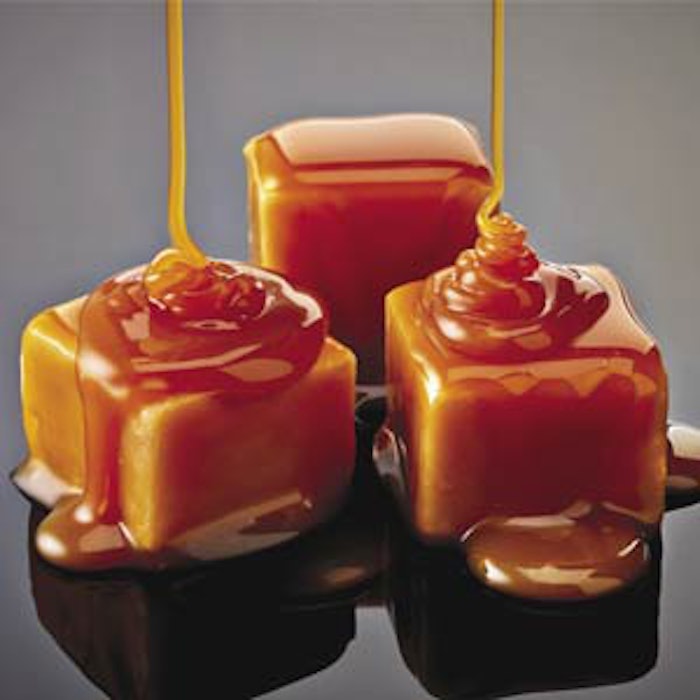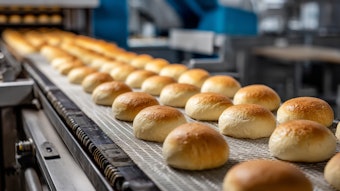
Furfural (FEMA# 2489, CAS# 98-01-1) is the most significant flavor compound generated during the heating of sugars in nature. The profile of furfural is, unsurprisingly, quite brown and caramelic. Underneath the obvious caramel character lurks more than a hint of the much harsher bitter almond note. This is also not surprising, given the close structural resemblance of furfural to benzaldehyde.
Two additional furan aldehydes also are generated in significant quantities during the caramelizing process: 5-methyl furfural (FEMA# 2702, CAS# 620-02-0) and 5 (hydroxy methyl) furfural (CAS# 67-47-0). 5-Methyl furfural has a much softer caramel note than furfural and also has much less of the harsh benzaldehyde secondary character. This makes it preferable to furfural in most applications, in this author’s opinion. 5 (hydroxy methyl) furfural is even softer, almost honey-like, but sadly does not perform well in respect of cost, regulatory acceptance or stability.
Given this simple comparison, 5-methyl furfural probably makes the best contribution to the caramel underpinning of a very wide range of flavors that derive a significant aspect of their overall profile from heated sugars. The dose rates given throughout this article are at levels suggested for use in flavors intended to be dosed at 0.05% in ready-to-drink beverages or simple bouillons.
Brown Flavors
Caramel: Levels of use of 5-methyl furfural in caramel flavors vary widely depending on the character of the flavors but 2,000 ppm is a good, middle-of-the-road starting point.
Coffee: The same comments apply equally to coffee flavors. Strongly roasted flavors can tolerate higher levels than mild coffee flavors. 2,000 ppm is also a good compromise in this flavor category, to be adjusted up or down depending on the profile.
Chocolate and cocoa: 5-Methyl furfural makes an important contribution to the caramel character of milk chocolate flavors and is also significant in cocoa and dark chocolate flavors. 1,500 ppm is an ideal level of addition to all three categories of flavors.
Brown sugar: Brown sugar flavors cover a wide spectrum of profiles, from dark molasses to simple unrefined sugars. All these categories can make good use of the addition of around 1,500 ppm of this ingredient.
Malt and malted milk: 1,500 ppm is also a good level of addition for this compound in these two flavor categories. It is especially effective in malted milk flavors, adding a soft-cooked, caramelic note, which blends well with the malt notes.
Bread: 5-Methyl furfural works well in almost all the different styles of bread flavors. Levels can vary but 1,000 ppm is a good starting point.
Black tea: Much lower levels of addition, around 500 ppm, are more appropriate in black tea flavors. At this level, this ingredient is effective in toning down brighter floral notes.
Maple syrup: Realistic maple syrup flavors need a subtle touch of the caramel character of 5-methyl furfural; 300 ppm is a good initial level to try. However, this ingredient is probably wasted in the traditional fenugreek-based flavors.
Vanilla bean: Authentic vanilla bean flavors are all about the subtle balance of a wide range of minor ingredients—and this ingredient can play a useful role at levels around 200 ppm.
Honey: 5-Methyl furfural is also only a subtle component of realistic honey flavors but can still be very effective, especially in floral honey flavors, at 200 ppm.
Savory Flavors
Bacon: 5-Methyl furfural is vital in bacon flavors and can often be incorporated at relatively high levels, starting at 2,000 ppm.
Toasted onion: At 2,000 ppm, this ingredient also works exceptionally well in all types of cooked onion flavors, giving them an attractive, sweet caramelic nuance.
Beef: This ingredient is applicable to the whole gamut of beef flavors, ranging from boiled to roasted. Levels of use can vary considerably for the different profiles but 1,000 ppm is a good starting point.
Smoke: Many smoke flavors are brutally phenolic but this ingredient is effective at smoothing out and softening this harsh profile at 1,000 ppm.
Chicken: Ideal levels vary for different chicken flavor profiles but 1,000 ppm is still a good initial level.
Ham: Typical ham flavors are given added depth by levels of 5-methyl furfural of around 500 ppm; slightly higher levels work well in honey roasted ham flavors.
Nut Flavors
Hazelnut: Levels of caramel notes in nut flavors require balance but there is no question that moderate levels perform a useful service. Caramel notes help to “flesh out” the otherwise thin aldehydic and ketonic notes that are often dominant. The best starting point in hazelnut flavors is 500 ppm.
Walnut: Walnut flavors generally have more intrinsic depth than hazelnut flavors but 5-methyl furfural can still be helpful at levels in the region of 400 ppm.
Almond: Toasted almond flavors can also make good use of this ingredient at similar levels of around 400 ppm.
Peanut: Similarly, 400 ppm of 5-methyl furfural is helpful in roasted peanut flavors, adding complexity and depth.
Alcoholic Drink Flavors
Rum: Rum flavors are, by far, the most effective home for 5-methyl furfural in the realm of alcoholic drink flavors. The ideal level of addition depends on the targeted style of rum. White rum flavors benefit from levels of around 200 ppm but dark rum flavors can use much higher levels of around 2,000 ppm.
Port wine: 1,000 ppm of this ingredient gives a good level of a soft caramel note in realistic port wine flavors.
Whiskey: Whiskey flavors can be dominated to an unpleasant degree by fusel notes but 5-methyl furfural is quite effective at smoothing out this effect. However, the best level of use is much lower than in rum flavors, i.e., around 100 ppm.
Fruit Flavors
Raisin: The most obvious use for 5-methyl furfural in fruit flavors is dried fruit flavors. This is especially true of raisin flavors, which can use up to 2,000 ppm to good effect.
Prune: Slightly lower levels, in the region of 1,000 ppm, are more appropriate for prune flavors.
Apricot: Finally, the best level of 5-methyl furfural with apricot depends on the desired effect; 500 ppm can create an attractive dried apricot profile but fresh apricot flavors also can benefit. They only need a trace addition of around 50 ppm to smooth the profile without turning it overtly caramelic.










